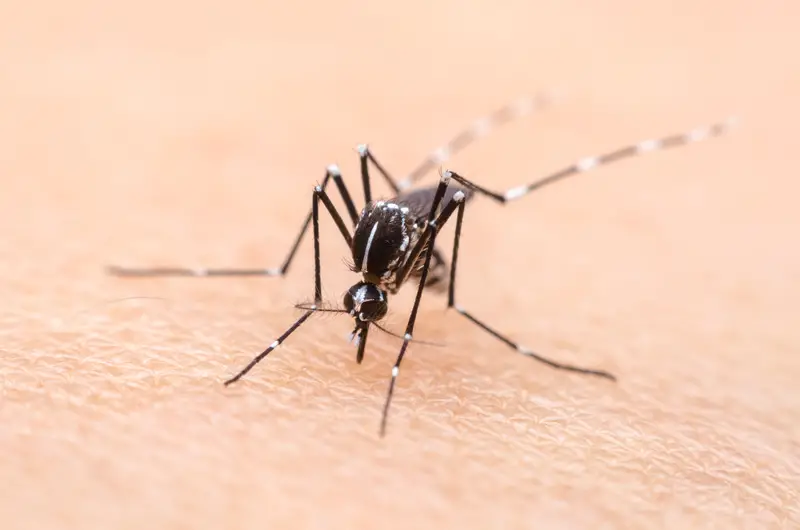That high-pitched buzzing sound outside your bedroom window isn’t just another annoying mosquito. Some mosquitoes carry dangerous diseases that can seriously harm you and your family. With cases of West Nile virus, dengue fever, and eastern equine encephalitis on the rise across the United States, knowing which mosquitoes to watch for could save your life. These tiny insects can detect you from 164 feet away and are getting better at spreading illness every year.
Disease-carrying mosquitoes look different than regular ones
Regular mosquitoes might just leave you with itchy bumps, but disease-carrying mosquitoes can transmit life-threatening illnesses. These dangerous mosquitoes often have distinctive markings that set them apart from common house mosquitoes. Aedes aegypti mosquitoes, which carry dengue fever, have white stripes on their legs and a lyre-shaped pattern on their backs. They’re smaller than typical mosquitoes and prefer to bite during daylight hours, especially in the early morning and late afternoon.
Culex mosquitoes, the main carriers of West Nile virus, are brown with lighter-colored bands across their abdomens. They’re most active at dawn and dusk, making them harder to spot during peak biting times. These mosquitoes prefer stagnant water sources like bird baths, gutters, and flower pots for breeding. If you notice mosquitoes with these specific markings around your home, you’re dealing with potentially dangerous insects that require immediate attention and proper repellent protection.
These states reported the most dangerous mosquito cases
Massachusetts experienced its first eastern equine encephalitis outbreak since 2020, with at least five states reporting cases this year. This rare but deadly virus causes severe brain infections and recently killed a New Hampshire resident. The CDC has issued health alerts about rising dengue fever cases, particularly threatening the Southeastern United States. West Nile virus cases appeared earlier than expected this year, with 33 states reporting 289 confirmed infections according to recent CDC data.
Southern states face the highest risk for dengue-carrying mosquitoes, while northern states deal more with West Nile virus carriers. Florida, Texas, Louisiana, and Georgia see the most Aedes aegypti activity throughout the year due to warm, humid conditions. California, Illinois, and New York report significant West Nile virus activity, especially during late summer months. If you live in these high-risk areas, checking your property for dangerous mosquito breeding sites becomes even more critical for protecting your family’s health.
Check these hidden breeding spots around your house
Female mosquitoes only need a bottle cap’s worth of standing water to lay hundreds of eggs. Gutters clogged with leaves create perfect nurseries for disease-carrying mosquitoes, especially after rainstorms. Flower pot saucers, pet water bowls, and birdbaths that sit unchanged for days become mosquito hotels. Even that decorative fountain you forgot to maintain can house thousands of developing mosquito larvae within a week of stagnant conditions.
Kids’ toys left outside after rain, tarps covering grills or outdoor furniture, and leaky outdoor faucets create ideal mosquito breeding conditions. Pool covers that collect rainwater, old tires in garages or sheds, and clogged storm drains near your property all contribute to dangerous mosquito populations. Tree holes, hollow fence posts, and even upturned trash can lids can harbor enough water for mosquito reproduction. Regular inspection of these areas every few days helps prevent dangerous mosquito species from establishing colonies near your home and threatening your family’s safety with larvicide treatments.
Dangerous mosquitoes bite at different times than others
Most people expect mosquito problems at dusk, but disease-carrying Aedes mosquitoes prefer attacking during broad daylight. These aggressive biters are most active from early morning until late afternoon, catching people off guard during outdoor activities. They often hide in shaded areas like under decks, in garages, or behind outdoor furniture, waiting for victims to come close enough for a quick meal.
Culex mosquitoes stick to traditional evening and dawn feeding schedules, but they’re much more persistent than regular mosquitoes. They’ll follow you indoors through open doors and windows, then hide in closets or under beds until you’re asleep. These sneaky insects can remain active well into fall months when other mosquitoes start dying off. Understanding these different biting patterns helps you prepare appropriate protection throughout the day, not just during typical mosquito hours when most people apply repellent.
Skip homemade repellents for dangerous mosquito protection
Pinterest and social media overflow with DIY mosquito repellent recipes using essential oils, apple cider vinegar, and vanilla extract. While these homemade concoctions might smell pleasant, they won’t protect you from disease-carrying mosquitoes. Dr. Linda Yancey, an infectious diseases specialist, explains that effective mosquito repellents require specific active ingredient concentrations only achievable through industrial equipment, not home kitchens.
Essential oils like rosemary, lemongrass, and peppermint lack sufficient concentrations to provide reliable protection against determined disease vectors. Even pure vanilla extract, which costs around $5 per ounce, only masks human scents temporarily without creating lasting barriers. The CDC and EPA recommend only EPA-registered insect repellents for protection against mosquito-borne illnesses. When dangerous mosquitoes threaten your health, stick with proven DEET-based repellents rather than gambling with homemade alternatives that might fail when you need protection most.
Create mosquito traps that actually work
Simple DIY mosquito traps can significantly reduce dangerous mosquito populations around your property without expensive professional treatments. The mosquito bucket method uses 3-5 gallon containers filled halfway with water, grass clippings, and mosquito dunks containing B.t.i. bacteria. This naturally occurring soil bacterium kills mosquito larvae without harming beneficial insects, pets, or garden plants. The decomposing organic matter produces carbon dioxide that attracts egg-laying females.
Position these buckets near outdoor seating areas, around pool perimeters, and close to suspected breeding sites for maximum effectiveness. Replace the dunks every 30 days but leave the water unchanged – swampy conditions actually improve trap performance. Success stories include complete mosquito elimination within two weeks in heavily infested areas. One Tennessee homeowner uses nine buckets around her property and can now sit outside comfortably after years of mosquito problems. These homemade traps target mosquitoes before they become biting adults, breaking the reproduction cycle effectively.
Hunt down single mosquitoes without toxic sprays
That single mosquito buzzing around your bedroom at night could be carrying dangerous diseases, making elimination crucial for safety. The flashlight hunting method works better than immediately spraying chemicals that create strong odors interfering with sleep. Turn off all room lights except one small light source like your phone or a small lamp. Mosquitoes naturally gravitate toward light sources, eventually landing on nearby walls or surfaces.
Once the mosquito approaches your light source, activate a flashlight and systematically sweep the beam across walls and surfaces. Reduced lighting conditions make it significantly easier to spot both the mosquito and its shadow. This chemical-free approach allows physical removal without introducing harsh spray odors into sleeping areas. The technique proves particularly valuable for nighttime encounters when maintaining air quality for comfortable sleep remains essential while still addressing immediate mosquito threats that could carry serious diseases.
Eat foods that make mosquitoes avoid you
Certain foods can alter your body chemistry to naturally repel mosquitoes, providing internal protection against disease carriers. Foods high in vitamin B1 (thiamine) cause your body to emit odors undetectable to humans but repulsive to mosquitoes. Tomatoes, beans, lentils, nuts, milk, oats, and oranges all contain significant thiamine levels. The Empire State Lyme Disease Association confirms this vitamin creates natural mosquito deterrence through skin secretions.
Citrus fruits contain nootkatone, a mosquito-repelling compound that works when consumed regularly. Fresh oranges, grapefruit, lemons, limes, and their juices create scents mosquitoes actively avoid. Coffee provides dual benefits of energy and bug deterrence through body scents that repel mosquitoes. Seaweed’s high iodine content makes skin secretions deter mosquitoes, though excessive intake should be avoided. Hot peppers also contribute to mosquito-repelling body chemistry. While these dietary approaches help reduce mosquito attraction, they work best combined with proven repellents when dangerous species threaten your area.
Install physical barriers that stop disease carriers
Physical barriers provide foolproof protection against dangerous mosquitoes without relying on chemicals or sprays that might fail. Gazebos with netted walls create completely mosquito-free zones for outdoor dining and relaxation. Mosquito nets draped from outdoor umbrellas offer portable protection for smaller spaces like patio tables or poolside seating. These barriers work regardless of mosquito species, biting times, or resistance to repellents.
Screen enclosures around porches and decks provide permanent solutions for homes in high-risk areas with dangerous mosquito populations. Portable popup screen shelters work well for camping, picnics, or temporary outdoor events where disease-carrying mosquitoes pose threats. Fine mesh screening prevents even the smallest Aedes mosquitoes from reaching you while maintaining airflow and visibility. These physical barriers prove especially valuable for families with young children, elderly members, or anyone with compromised immune systems who face higher risks from mosquito-borne diseases.
Don’t take chances with mosquitoes that could be carrying deadly diseases like West Nile virus, dengue fever, or eastern equine encephalitis. Regular property inspections, proper identification of dangerous species, and effective control methods protect your family from serious health threats. Take action now to eliminate breeding sites and implement proven protection strategies before these disease vectors establish permanent colonies around your home.

